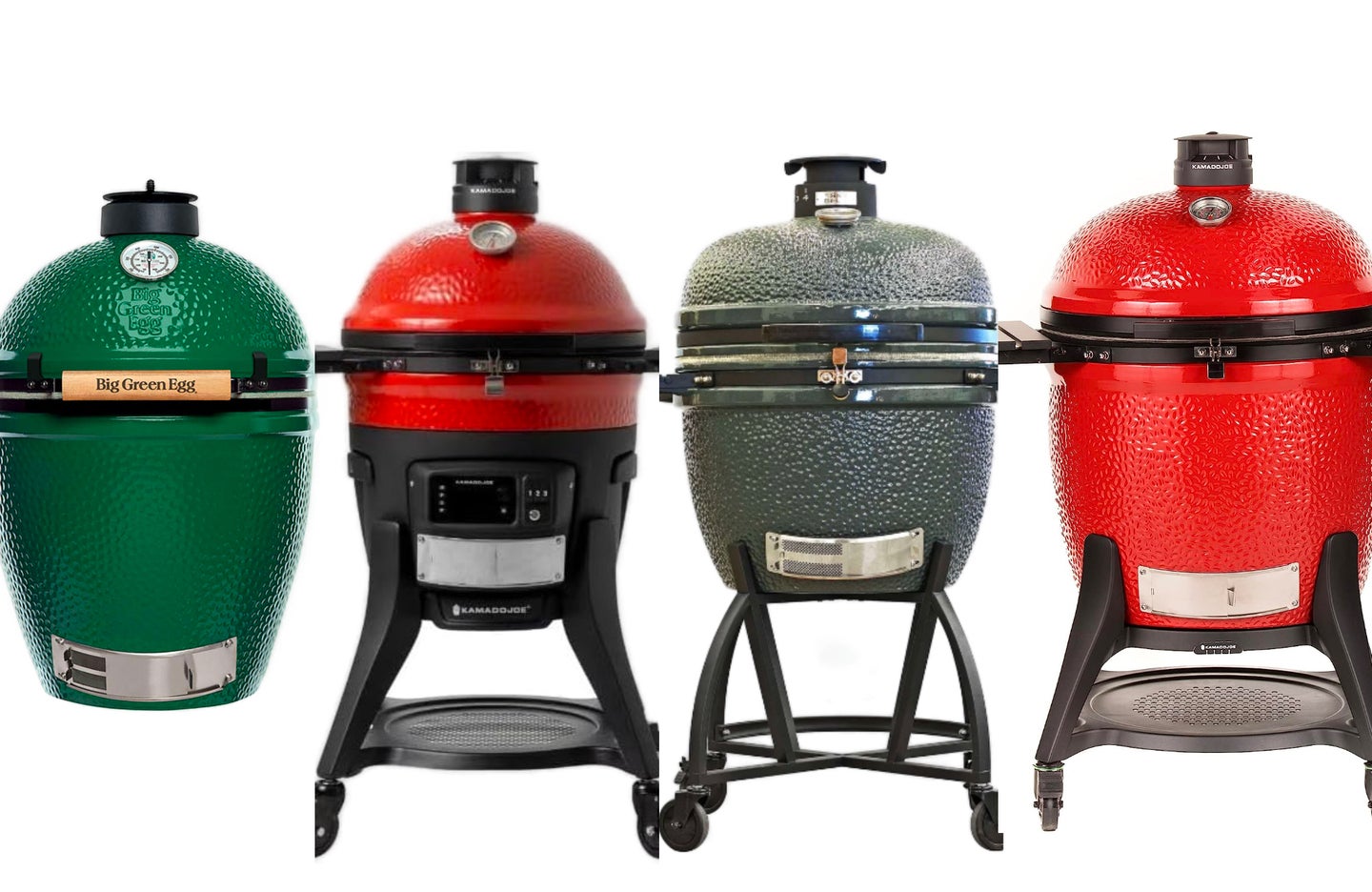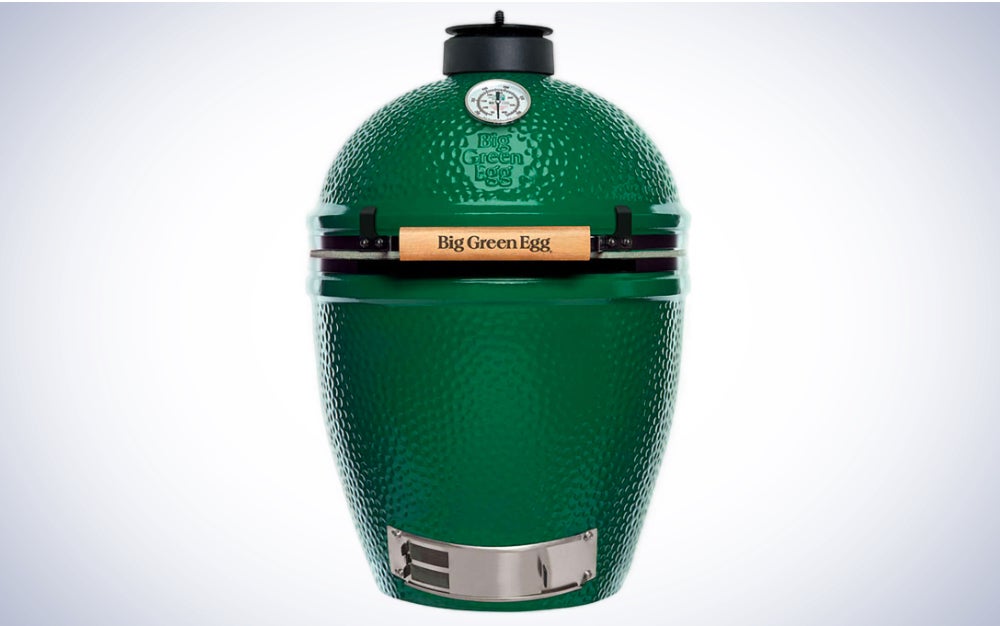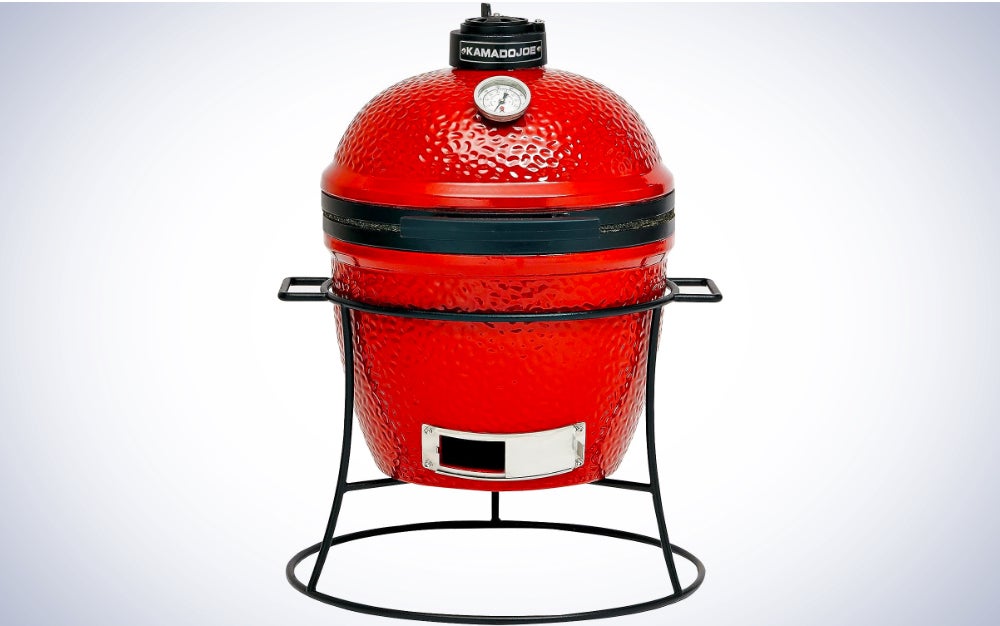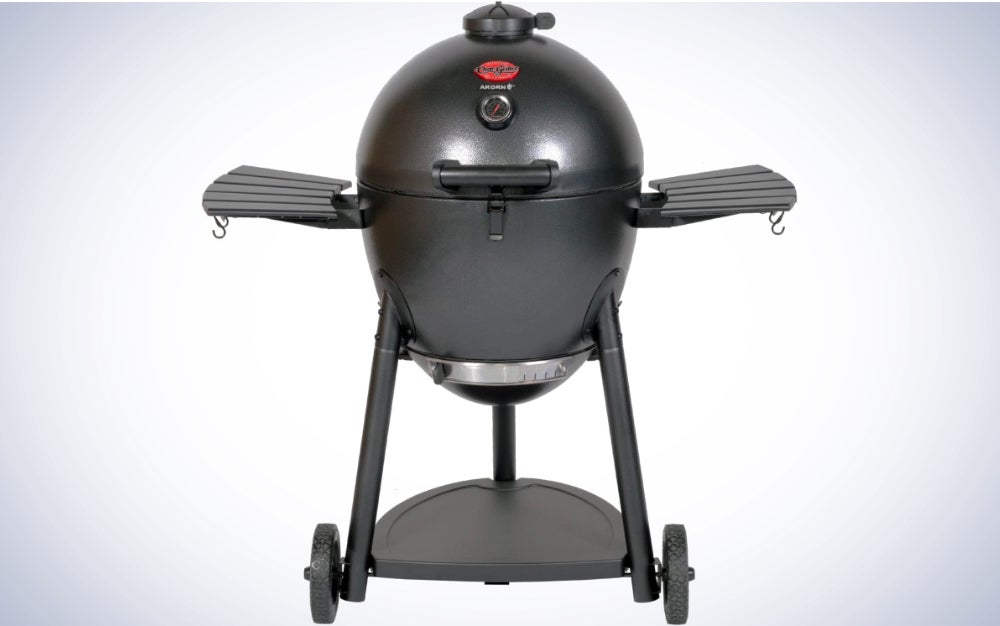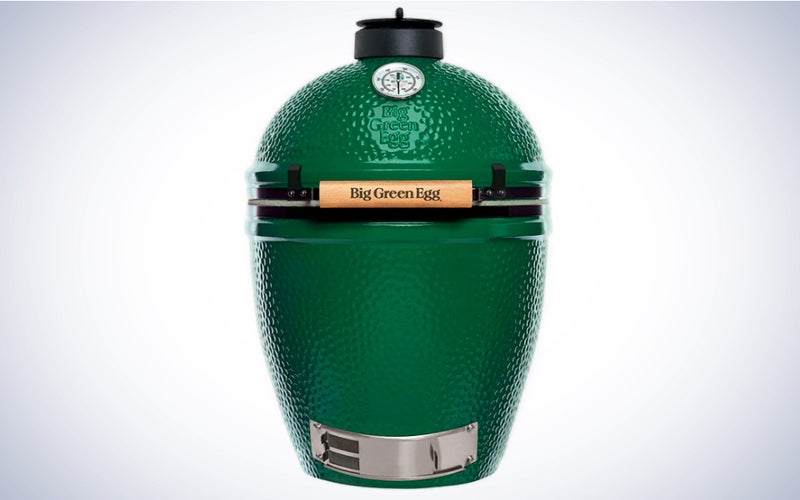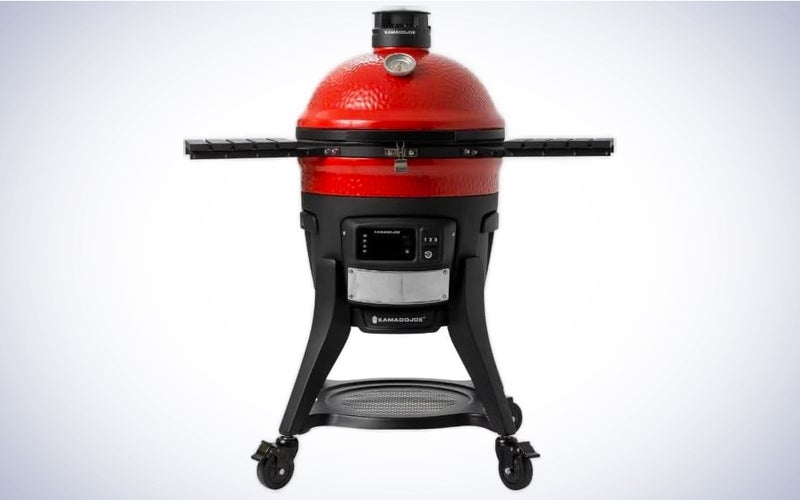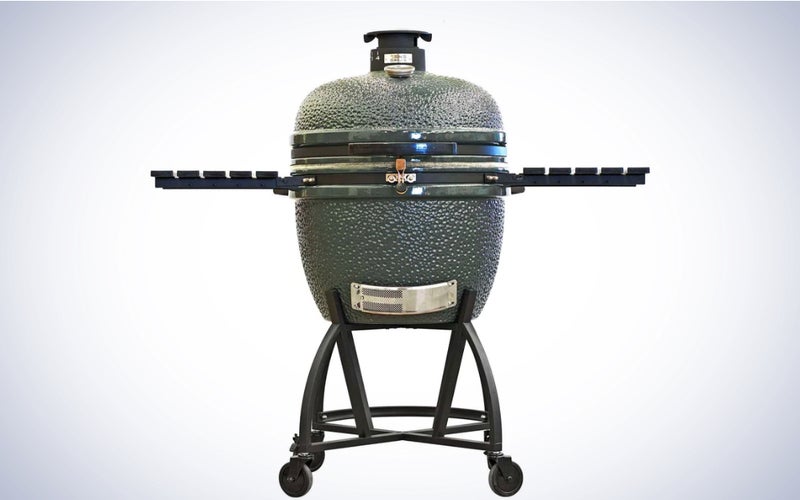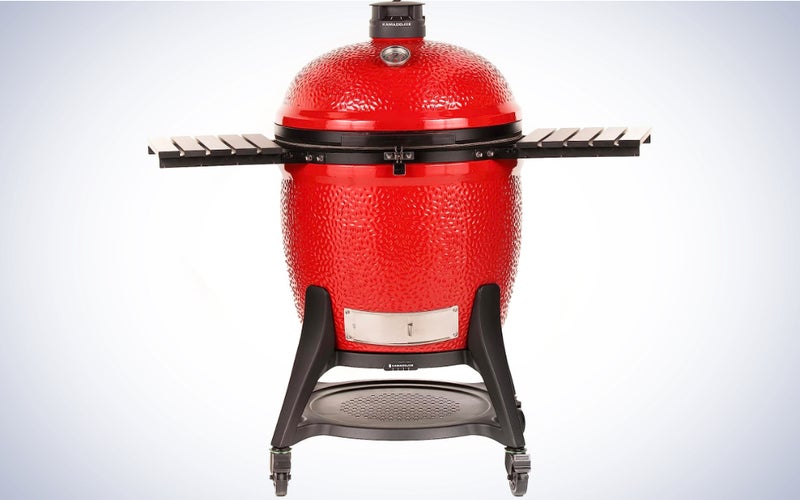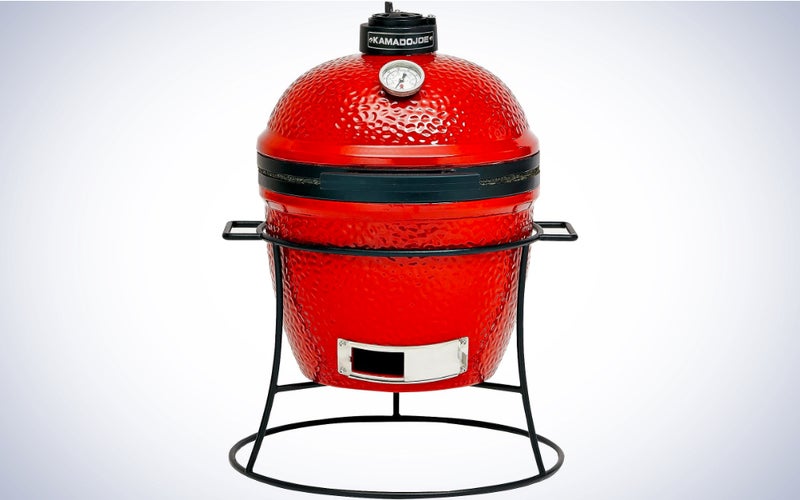We may earn revenue from the products available on this page and participate in affiliate programs. Learn more ›
Summer might be over, but with a kamado grill, grilling season never has to end. Air fryers might be all the rage these days, but there’s something special about meat (or vegetables) cooked over flame. While Hank Hill might disagree, grilling with a kamado grill is one of the best ways to prepare that meat (and vegetables). If you aren’t familiar, a kamado grill is a traditionally ceramic grill (though some are steel) known for its precise temperature control and fantastic insulation. They are generally shaped like large eggs, inspiring a very popular brand name. Kamado grills are extremely versatile, handling smoking duties, roasting, baking, and slow cooking. Kamado grills come in several variations, from basic charcoal grills to more complex dual-level versions. There are connected grills and small ones that you can take camping. No matter your preferences, one of the best kamado grills we’ve selected is sure to satisfy.
- Best overall: Big Green Egg 18.5-inch
- Best smart: Kamado Joe Konnected Joe
- Best two-zone: Slow ‘N Sear Deluxe Kamado Gen 2
- Best large: Kamado Joe Big Joe III
- Best small: Kamado Joe Joe Jr.
- Best budget: Char-Griller Akorn Kamado
How we chose the best kamado grills
If we had the time to review each of these grills personally, our doctors would surely lecture us on the amount of smoked ribs and brisket we’ve consumed. Instead, we combined a reasonable amount of cholesterol with recommendations from grill enthusiasts and research across the internet and multiple retailers. This led us to the most highly rated kamado grills and the best in each category. While there is always some subjectivity to choosing the best of anything, the trick with these kamado grills is ensuring that customer reviews are primarily positive and that the brands themselves are respected and reputable.
The best kamado grills: Reviews & Recommendations
When we light that charcoal, we want something we can rely on to cook our meat. That’s why we chose these particular kamado grills. Sure, there’s a big name at the top, but whether you are looking for something to take camping with you or something heavier that lives on your patio, these six grills have got you covered.
Best overall: Big Green Egg 18.5-inch
Big Green Egg
Why it made the cut: If the question is about kamado grills, then Big Green Egg usually is the answer.
Specs
- Diameter: 18.25 in.
- Cooking area: 262 sq. in.
- Material: Ceramic
Pros
- Versatile griller and smoker
- Sturdy build
- Conservative fuel use
Cons
- Heavy (~200lbs)
- A bit on the expensive side
The Big Green Egg brand has been around since 1974, and its 18.5-inch Big Green Egg 18.5-inch is one of the best selling kamado grills in existence. While that alone is not a reason to buy a thing, it has backed up its brand recognition with a product that routinely graces the top of Top 10 lists year after year and turns regular grill people into hardcore grilling enthusiasts. It has a loyal following and numerous grilling festivals in its name around the country every year.
What you are paying for is both brand name and reliable construction. The Big Green Egg doesn’t come with a stand like some kamado grills, preferring to sit on its little metal feet. It’s air-tight, ceramic glazed with porcelain for durability, and has a built-in temperature gauge. There are two vents for managing temperature control and a stainless steel cooking grid. To put its 262 square inches of cooking space into perspective, that’s enough for a dozen burgers or a big ‘ol turkey. You may need to add some accessories, like a stand, a pizza stone, or a ceramic heat deflector, but grilling always has the side effect of buying grilling tools.
When it comes to versatility, whether you’re smoking, searing, or grilling, the Big Green Egg 18.5-inch is the first item on many a kamado grill shopping list.
Best smart: Kamado Joe Konnected Joe
Kamado Joe
Why it made the cut: If you want all the quality of a kamado grill mixed with the luxury of modern technology, you’ll want to get Konnected.
Specs
- Diameter: 18 in.
- Cooking area: 250 sq. in.
- Material: Ceramic
Pros
- WiFi enabled
- Full ceramic build
- Built-in connected controls
Cons
- Some units shipped incomplete
- Expensive
The Kamado Joe Konnected Joe has taken to Mortal Kombat naming conventions when it komes to its included features. It doesn’t have a control board; it has a Kontrol Board. It doesn’t have a top vent to maintain air settings during opening and closing the dome; it has a Kontrol Tower top vent. It also has an automatic fire starter. No misspellings there. Between its WiFi app connectivity, multiple cooking modes, digital fan, and Kontrolled temperature settings, you can reach precise cooking enlightenment.
It has space for 13 burgers, four whole chickens, or two pork shoulders. Or several pounds of red bell peppers. It’s your call. It does clock in at 175 pounds, but does stand on wheels, so you can move it if you need to. The digital controls are great if you are just getting into smoking, as that can be a sweaty and stressful manual process. Maintaining a temperature of 250 degrees over 18 hours for a brisket is much easier when you have an app. While traditionalists might disagree with that assessment, we just wanna eat. So relax, because it also has a classic mode which allows you to manage the temperature manually. So yeah, the Kamado Joe Konnected Joe has something for everyone, no matter your level of grill expertise, and makes a delicious addition to a smart home (just make sure you’ve got a WiFi router with enough range to reach the patio).
Best two-zone: Slow ‘N Sear Deluxe Kamado Gen 2
Slow ‘N Sear
Why it made the cut: Slow ‘N Sear specializes in two-zone grilling, and yes, it produces a kamado grill.
Specs
- Diameter: 22 in.
- Cooking area: 363 sq. in. / 180 sq. in.
- Material: Ceramic
Pros
- Two-zone cooking
- Lifetime warranty
- Also comes as an insert
Cons
- Expensive
- Steep learning curve
Slow ‘N Sear is known for producing two-zone cooking inserts for your existing kamado, but the Slow ‘N Sear Deluxe Kamado Gen 2 cuts out the middleman and offers everything in one package. If you aren’t familiar with two-zone cooking, it’s when the charcoal isn’t at the bottom of the kamado but instead up and off to the side. This creates a lower section for high-heat searing and grilling and an upper section for indirect smoking. This allows for reverse-sear grilling (you smoke the meat first, then put the top grate back on over the offset heat source and sear the meat). You can’t ask for a better method of caramelization.
The top vent on this unit is rainproof; you can add an elevated cooking grate for an additional 180 square inches of cook surface; and the lower grate is cast iron. There’s a ceramic deflector plate, ash tool, and compatibility with many after-market temperature control accessories. While there are no digital controls, you won’t need them once you learn all about two-zone grilling. You’ll be a two-zone master, precisely turning the top vent to its optimal airflow position and spacing out your meat at a perfect distance from the heat. The Slow ‘N Sear Deluxe Kamado Gen 2 might have once been an accessory, but now it’s a well-constructed and masterful two-zone grilling machine.
Best large: Kamado Joe Big Joe III
Kamado Joe
Why it made the cut: In the landscape of kamado grills, they don’t come any beefier than this.
Specs
- Diameter: 24 in.
- Cooking area: 450 sq. in.
- Material: Ceramic
Pros
- Tons of cooking space
- Room for multiple tiers
- Uses science to smoke
Cons
- Super expensive
- Very heavy
The Kamado Joe Big Joe III is the big unit of kamado grills. While size isn’t everything, this kamado backs up its massive interior with a truly scientific approach to smoking those three pork butts. Using Harvard science research, its SlōRoller Hyperbolic Smoke Chamber distributes smoke and heat in rolling, recirculating waves to engulf your food in clouds of perfect smoke while simultaneously distributing heat. This creates an even cook and eliminates hot spots. Except for that one hot spot right on the fat tip of that pork butt, because that’s the best part. Get some flame on that.
With its size, you’d assume that there would be room on the inside for multiple cooking tiers, and you’d be correct. There’s a half-moon design on the inside to allow for three cooking levels, so you could literally high-heat sear while smoking something else. That’s super handy if you need snacks while waiting for your meat to smoke. The air lift hinge (common in all Kamado Joe products) makes it easy to lift the lid, and a galvanized steel cart with wheels ensures you can place the grill exactly where you want it. The rain-resistant Kontrol Tower Top Vent keeps your meat cooking perfectly from 225F up to 750F. If you have the space and the meat in your drop freezer, the Kamado Joe Big Joe III can handle all of it.
Best small: Kamado Joe Joe Jr.
Kamado Joe
Why it made the cut: If you want small without losing quality and reliable grilling, look no further.
Specs
- Diameter: 13.5 in.
- Cooking area: 150 sq. in.
- Material: Ceramic
Pros
- Totally portable
- Built-in Temp gauge
- Handles for easy carry
Cons
- Only fits one pork butt
- Takes a while to heat up
- Can be wobbly on the stand
If you want to get into the world of kamado grilling without spending too much and with the freedom of portability, then the Kamado Joe Joe Jr. is the grill you are looking for. It has all the reliability and structural confidence of larger Kamado Joe grills without the massive size. It weighs well under 100 pounds and might only hold one pork butt, but sometimes that’s all you need. The cast iron air vent helps maintain temperature and airflow, a slide-out ash drawer keeps the mess at a minimum when cleaning, and its side handles make for quick carry to the campsite.
For the under $500 price, it’s no stretch to add on some much-needed accessories. Pick up a soapstone for grilling fish, a charcoal basket for creating separate cook zones, and a cast iron sear plate for searing perfect lines on that NY Strip. It’s tough to find a name-brand kamado grill for this kind of price, much less a ceramic one. Most of the smaller, cheaper kamado grills are insulated stainless steel. That’s fine for the short term, but ceramic lasts a lot longer. The Kamado Joe Joe Jr. is the perfect entry-level kamado or makes a great addition to your growing grill collection.
Best budget: Char-Griller Akorn Kamado
Char-Griller
Why it made the cut: As an entry-level kamado grill, the Akorn offers a low price and moderate portability.
Specs
- Diameter: 20 in.
- Cooking area: 447 sq. in.
- Material: Insulated steel
Pros
- Large cooking area
- Built-in temperature gauge
- Comes with stand (and wheels)
Cons
- Not ceramic
- Doesn’t create a perfect seal
- Best for high heat grilling
The Char-Griller Akorn Kamado is a well-reviewed kamado grill, but the few negative reviews seemed to indicate two things: the inexperience of the reviewers (of their own indication) and that the Akorn works best for high-heat grilling rather than smoking. However, those reviews make up less than one percent of total reviews, so it’s hard to assume that this is anything less than a well-performing grill priced for affordability. The sub-$400 pricing is likely due to the construction. Rather than the traditional ceramic, the Akorn is triple-walled insulated steel. It’s still sturdy and still maintains heat (though may require some heat tape to seal it up fully), and the steel weighs a lot less than ceramic. So, it’s not totally negative.
There are adjustable top and bottom dampers, so you can control how fast those ribs are cooking. There’s a nice little warming rack and cast iron cooking grates. The side shelves fold down, and the wheels lock and unlock so you can scoot your grill wherever you need it. And if you’ve ever had to clean a kamado grill, you know it’s a bit of a pain. Well, this one has an easy dump ash pan, so you can quickly get ready for your next grilling session. Overall, if you want to get into the kamado grilling game without spending tons of money, but still receiving a quality grill, the Char-Griller Akorn Kamado is the way to go.
What to consider before buying a kamado grill
In purchasing a kamado grill, you’ll want to consider some of the same things you’d think about when purchasing a traditional propane or charcoal grill. That is, its available accessories and temperature range. However, since kamado grills are a bit different (and shaped like eggs), you’ll want to add a few considerations to that list. Whereas most propane grills and other types of gas grills are some variation of steel, kamado grills are often ceramic. From there, paying attention to grilling surface area and fuel type will ensure you’re making the right investment in a grill that should last you quite a while.
Grilling surface area
Kamado grills are designed for maximum fuel efficiency. What this means is that whether you are cooking a single burger or a few racks of ribs, you can easily scale your usage. So, when it comes to surface area, you want to gauge how much you grill on average and plan accordingly. A few inches can make the difference between smoking a pork butt while trying to quickly sear a few sausages at the same time. Plus, many larger grills allow for multiple cooking zones.
Fuel type
Most kamado grills call for lump charcoal, though some brands will work with briquettes. However, those are harder to use as a smoker. The important thing to remember is to never use lighter fluid or instant-light charcoal in a ceramic kamado. If you do, everything you cook will taste like lighter fluid.
Material
A kamado grill, as implied by the prices, is an investment. So you want that investment to last. There are two main materials that kamado grills are made of. Ceramic is the most common. Insulated stainless steel comes in second. And that’s about it. The main differences are that ceramic heats up faster and retains heat better, while stainless steel is lighter and stronger (and cheaper). And don’t just focus on the grill itself; pay attention to the material of the handles, hinges, flanges, and seals.
FAQs
Q: What is so great about a kamado grill?
Its versatility. You can use a kamado grill as a standard grill, a smoker, a roaster, a searing machine, a high-heat broiler, and so on. There are tons of accessories out there to maximize the usage of a kamado grill. The only thing it’s not is a microwave.
Q: Can I leave my kamado grill outside in the elements?
Short answer: yes. However, you’ll want to purchase a grill cover for your kamado. This will prevent moisture from entering the grill. Frozen water can lead to cracks in the ceramic. And, after each use, you’ll want to open the vent and lzt all the moisture out to prevent rusting on the stainless steel parts (if any).
Q: Can I cook pizza on a kamado grill?
Absolutely. One of the best accessories for a kamado grill is a pizza stone. Preheat the stone, then cook at a high temperature and bingo-bango, you’ve saved money on delivery (or a dedicated pizza oven) and can add all the toppings you want at a fraction of the cost.
Q: How much does a kamado grill cost?
This depends on its size and features, but our recommendations cost between $348 and $1,700.
Final thoughts on the best kamado grills
- Best overall: Big Green Egg 18.5-inch
- Best smart: Kamado Joe KJ15041123
- Best two-zone: Slow ‘N Sear Deluxe Kamado Gen 2
- Best large: Kamado Joe Big Joe III
- Best small: Kamado Joe Joe Jr.
- Best budget: Char-Griller Akorn Kamado
Because of the sheer versatility of kamado grills, picking the best kamado grills of 2023 is a delicious assignment. Kamado grills can replace most grills and smokers under one egg-shaped lid. And the best part is that kamado grills aren’t just for grilling experts or professionals; they are suited for anyone willing to take the time to learn how to feed the beast and manage heat. And some kamado grills will even do that for you. There are two major brands worth considering at the start—Big Green Egg and Kamado Joe—and from there, plenty of brands have competitive offerings. The trick is to find the best grill for your patio, whether a 400-pound beast or something you can take camping with you. The end result is the same: melt-in-your-mouth meat and vegetables cooked to perfection.
Why trust us
Popular Science started writing about technology more than 150 years ago. There was no such thing as “gadget writing” when we published our first issue in 1872, but if there was, our mission to demystify the world of innovation for everyday readers means we would have been all over it. Here in the present, PopSci is fully committed to helping readers navigate the increasingly intimidating array of devices on the market right now.
Our writers and editors have combined decades of experience covering and reviewing consumer electronics. We each have our own obsessive specialties—from high-end audio to video games to cameras and beyond—but when we’re reviewing devices outside of our immediate wheelhouses, we do our best to seek out trustworthy voices and opinions to help guide people to the very best recommendations. We know we don’t know everything, but we’re excited to live through the analysis paralysis that internet shopping can spur so readers don’t have to.
